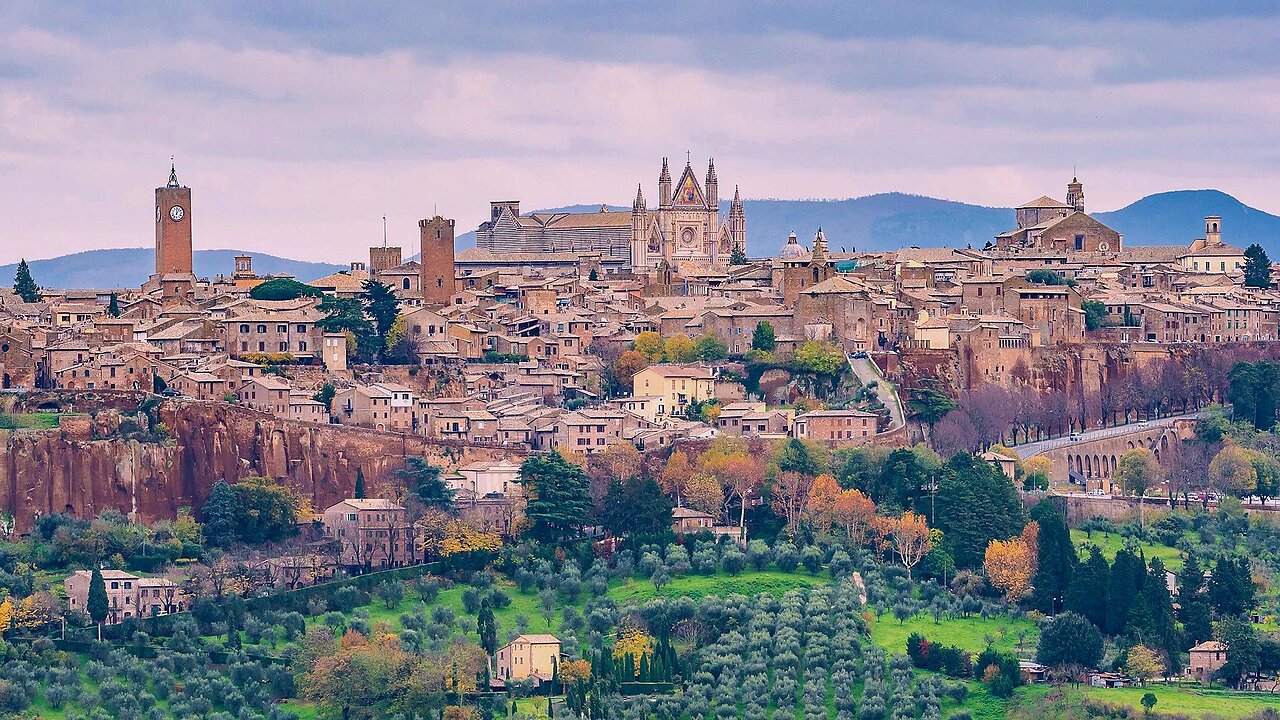Premium Only Content

Orvieto (AUD ENG)
Orvieto is a city and comune in the Province of Terni, southwestern Umbria, Italy, situated on the flat summit of a large butte of volcanic tuff. The city rises dramatically above the almost-vertical faces of tuff cliffs that are completed by defensive walls built of the same stone.
The ancient city (urbs vetus in Latin, whence "Orvieto"), populated since Etruscan times, has usually been associated with Etruscan Velzna, but some modern scholars differ. Orvieto was certainly a major centre of Etruscan civilization; the archaeological museum (Museo Claudio Faina e Museo Civico) houses some of the Etruscan artifacts that have been recovered in the immediate area. A tomb in the Orvieto Cannicella necropolis bears the inscription mi aviles katacinas, "I am of Avile Katacina"; the tomb's occupant thus bore an Etruscan-Latin first name, Aulus, and a family name that is believed to be of Celtic origin (derived from "Catacos").
Orvieto was annexed by Rome in the third century BC. Because of its site on a high, steep bluff of tuff, a volcanic rock, the city was virtually impregnable. After the collapse of the Roman Empire its defensible site gained new importance: the episcopal seat was transferred from Bolsena, and the city was held by Goths and by Lombards before its self-governing commune was established in the tenth century, in which consuls governed under a feudal oath of fealty to the bishop. Orvieto, sitting on its impregnable rock controlling the road between Florence and Rome where it crossed the Chiana, was a large town: its population numbered about 30,000 at the end of the 13th century.
The city of Orvieto has long kept the secret of its labyrinth of caves and tunnels that lie beneath the surface. Dug deep into the tuff, a volcanic rock, these secret hidden tunnels are now open to view only through guided tours. The underground city boasts more than 1200 tunnels, galleries, wells, stairs, quarries, cellars, unexpected passageways, cisterns, superimposed rooms with numerous small square niches for pigeon roosts, detailing its creation over the centuries. Many of the homes of noble families were equipped with a means of escape from the elevated city during times of siege through secret escape tunnels carved from the soft rock. The tunnels would lead from the city palazzo to emerge at a safe exit point some distance away from city walls.
The city became one of the major cultural centers of its time when Thomas Aquinas taught at the studium there. A small university (now part of the University of Perugia), had its origins in a studium generale that was granted to the city by Pope Gregory IX in 1236. The territory of Orvieto was under papal control long before it was officially added to the Papal States. It remained a papal possession until 1860, when it was annexed to a unified Italy.
-
 45:48
45:48
Adaneth - History&Politics
3 days agoGeorge Washington - Founding Father
49 -
 LIVE
LIVE
Dr Disrespect
5 hours ago🔴LIVE - DR DISRESPECT - BATTLEFIELD 6 - REDSEC - 10 WINS CHALLENGE
11,723 watching -

Russell Brand
4 hours agoFrom Curb Your Enthusiasm to Courage — Cheryl Hines on Hollywood, RFK Jr. & Speaking Out - SF646
42.1K10 -
 1:30:26
1:30:26
The Quartering
3 hours agoWoke Is Back!
87.1K24 -
 1:18:21
1:18:21
DeVory Darkins
4 hours agoTrump issues CHILLING WARNING to GOP as SCOTUS hears arguments regarding Tariffs
82.4K62 -
 3:35:48
3:35:48
Barry Cunningham
4 hours agoBREAKING NEWS: PRESIDENT TRUMP SPEECH AT THE MIAMI BUSINESS FORUM! (MIKE JOHNSON PRESSER)
52.4K7 -
 2:04:47
2:04:47
The Charlie Kirk Show
4 hours agoOnward | Henderson, Laurie, Miles | 11.5.2025
77.2K25 -
 2:15:52
2:15:52
Steven Crowder
7 hours agoWho is the Real Myron Gaines | Ash Wednesday
298K387 -
 1:07:53
1:07:53
Sean Unpaved
3 hours agoRankings, Recaps, & Deadline Deals: CFB Shake-Ups & NFL Trades
37.2K3 -
 2:13:33
2:13:33
Side Scrollers Podcast
5 hours agoAsmongold SUED for Emotional Distress + Hasan REJECTED+ INSANE Plane Crash + More | Side Scrollers
38.6K13